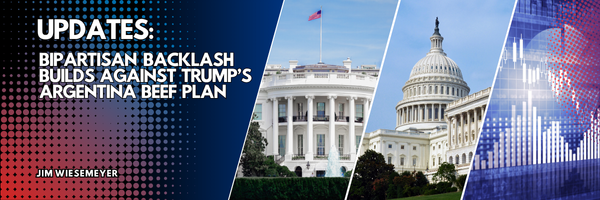
Bipartisan Backlash Builds Against Trump’s Argentina Beef Plan
Trump’s plan to expand Argentine imports and financial aid sparks rare pushback from both GOP farm-state lawmakers and Senate Democrats
The Trump administration’s proposal to dramatically expand beef imports from Argentina has triggered sharp opposition from cattle-state Republicans, Senate Democrats and rancher groups, who argue the move undermines domestic producers and contradicts the administration’s “America First” trade agenda.
The plan will reportedly quadruple Argentina’s beef import quota to 80,000 metric tons, primarily lean trimmings used in ground beef. The White House frames the change to ease food inflation and bolster supply amid a historic cattle shortage (America First for consumers), but lawmakers say it risks undercutting U.S. ranchers who are just beginning to recover from years of drought and high input costs.
Sen. Steve Daines (R-Mont.) told reporters that several members of the Congressional Beef Caucus raised their concerns directly with Vice President JD Vance, who “received the message” and pledged to relay it to President Trump. “Let’s just say message received,” Daines said. But Trump’s comments in Japan today is not helping the situation up on Capitol Hill. Trump said prices are down “except for the beef, which I’ll get down.” Trump said maybe ranchers are “doing too good now, but we want them to do well, but we have to get the beef prices down.” The president made the remarks during a dinner with business leaders in Tokyo
Sen. Mike Rounds (R-S.D.) warned that expanding imports “would only exacerbate the problem and hurt domestic producers,” calling for an “America First game plan that prioritizes American ranchers.”Rep. Mark Alford (R-Mo.) echoed those concerns, labeling the plan “misguided.”
House Ways & Means Chair Jason Smith (R-Mo.) has added to the chorus of criticism, saying he personally urged Trump to abandon the import plan. Smith warned that expanding Argentine beef imports would do little to lower grocery prices while “further squeezing U.S. ranchers already facing drought, high feed costs, and herd reductions.”
“While I agree with the president that, despite lower inflation, the cost of food is still too high for many working families, I strongly disagree with the idea that purchasing beef from Argentina will have a meaningful impact on prices at the store,” Smith said in remarks reported by Inside U.S. Trade.
Smith’s intervention underscores deepening divisions among farm-state Republicans over the administration’s reliance on foreign sourcing to curb food inflation. Industry groups and lawmakers say the policy contradicts Trump’s “America First” agenda and could deter investment in rebuilding U.S. herds and processing capacity.
Meanwhile, Senate Democrats led by Amy Klobuchar (D-Minn.) and Elizabeth Warren (D-Mass.) are pressing Treasury Secretary Scott Bessent to reconsider a $20 billion aid package to Argentina, arguing it prioritizes foreign nations over U.S. farmers.
In a letter (link) co-signed by 19 Democrats — including Senate Majority Leader Chuck Schumer (D-N.Y.) — the senators warned that the aid package “threatens to continue to close markets for American farmers” already burdened by tariff-driven inflation and weaker export demand. They pointed to falling Chinese purchases of U.S. grains, writing that “in a typical year China would have normally booked 15.4 million metric tons of soybeans, corn, wheat, and sorghum by the end of August. This year there have been no outstanding sales.” The senators urged Bessent to “immediately reconsider further aid to Argentina and instead focus on restoring and expanding long-term export market access for American farmers.”
Together, the objections from Smith and other Republicans and Senate Democrats represent a rare bipartisan convergence linking trade, aid, and rural economics—challenging the administration’s twin efforts to fight food inflation and deepen Latin American partnerships.
The National Cattlemen’s Beef Association joined the opposition, with CEO Colin Woodall saying the policy “harms U.S. cattle producers and does nothing to lower grocery prices.”
Meanwhile, USDA Secretary Brooke Rollins defended the plan, arguing that easing import restrictions could help lower beef prices for consumers while also addressing processing concentration among a handful of dominant packers.
Analysts note that Argentina currently supplies only about 2% of U.S. beef imports, meaning the quota expansion may have limited immediate impact on retail prices. Still, the optics have drawn scrutiny: ranchers in the Plains states described the move as a “gut punch” after finally seeing stronger prices this year.
Beyond the economics, the debate underscores a political risk for the Trump administration: alienating rural constituencies that form the backbone of Trump’s electoral coalition. Lawmakers say they will continue pressing the White House to reconsider the policy and restore confidence in domestic beef producers.
What’s Next
The administration is expected to release final details of the Argentina beef import plan soon, including the quota size, tariff rates, and safeguard measures.
Congressional action: Lawmakers are preparing letters, hearings, and legislation to seek transparency or changes to the plan, including country-of-origin labeling (COOL) reforms, packer competition oversight, and origin disclosure rules.
Domestic herd support: Implementation of cattle-herd expansion programs, feedlot support, and pasture recovery efforts will be critical to determining whether domestic supply can recover as the administration intends.
Market signals: Over the next 6–12 months, analysts will closely watch retail and wholesale beef prices to assess whether expanded imports genuinely reduce consumer costs—or merely reinforce packer dominance while undercutting U.S. ranchers.
Feeder Cattle Futures Slide Deepens as Contracts Hit Three-Month Low
Jan. 2026 feeder cattle contract off by double-digits in dollars as bulls scramble to arrest the breakdown
The Jan ’26 feeder cattle futures contract has slipped sharply since the policy spotlight turned toward beef pricing, with a price erosion of roughly $50 to $55 per cwt nearly 15%) from its recent high.
On the day the Trump administration publicly flagged its intention to bring down beef prices, feeder-cattle futures plunged. The high for the feeder cattle contract hit about $381 per cwt in late October 2025.
More recent settlement data show a close around $324.875 per cwt for the Jan ’26 feeder-cattle contract.
But the Argentine beef trade actions are symbolic in nature — 80,000 MT would only be 4% of current beef imports of around 2 MMT and just over 1/2% of current total beef consumption. That suggests the price moves are more speculative than due to fundamentals. Some of it is that the markets also had become overbought and were ripe for a correction.
The drop in feeder cattle futures is occurring amid broader market stress (liquidation, policy uncertainty, cattle supply/demand shifts) and cannot be attributed solely to the policy comment.
The other factor that has been weighing on feeder cattle futures: reports on the Mexican ag minister coming to the U.S. to negotiate a reopening of the border. That would open direct competition for domestically raised feeders. There is also market speculation that the U.S. could alter tariffs on Brazil in the wake of the Trump-Lula meeting.
Market implications
A nearly 15% decline in feeder cattle futures signals growing concern among market participants about either oversupply, weaker feeder‐cattle demand (for finishing), or policy risk (e.g., beef‐price pressure, import changes) — or some combination thereof.
For producers, sharper losses in feeder futures increase hedging cost and basis risk; some may cut back placements or alter feeding strategies.
For the stockings side: bulls (long positions) are under pressure, and stabilization efforts will likely focus on whether cash cattle auctions, finishing margins and cattle rancher sentiment show signs of support.
From a policy angle: if this futures slide persists, it raises questions about whether the administration’s efforts to reduce beef prices might unintentionally compress upstream prices (feeder/finishing) and risk rancher margin stability.
Outlook:If the policy narrative continues to drive uncertainty around beef pricing, then further downside risk exists in feeder futures — especially if cash market fundamentals weaken or if speculative long liquidation accelerates.
The next key test will come in early November, when cash auction prices and placement data offer clues about whether the market can stabilize or faces another leg lower.



